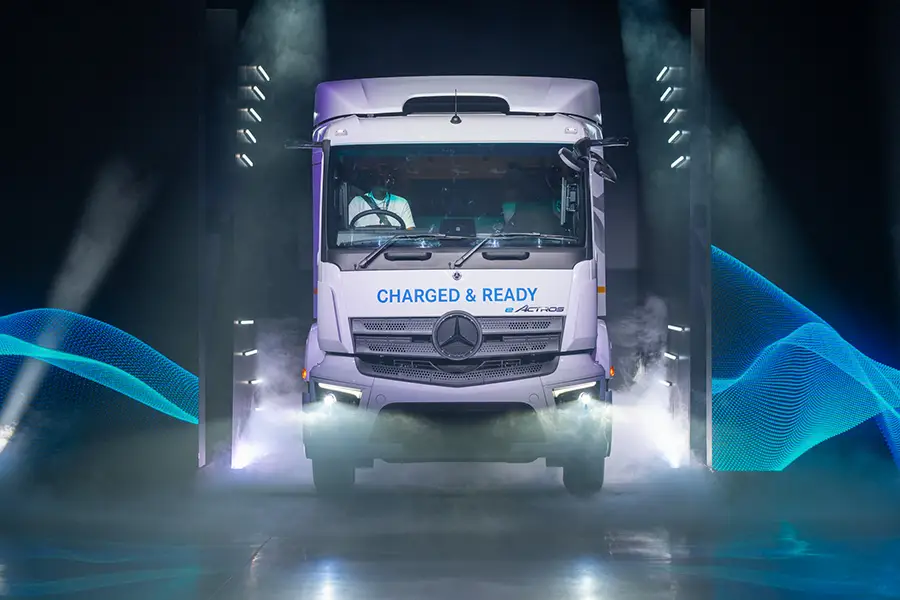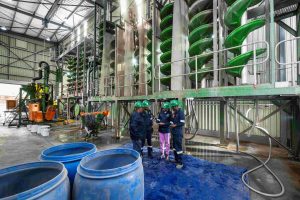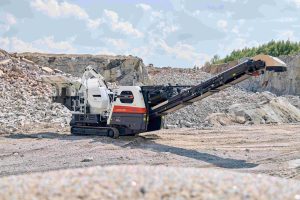Under the ‘Power Up’ theme, DTSA marked the first step towards its quest for sustainable transport at a launch event attended by dealers and customers in Lanseria, Johannesburg on May 21, 2024. In the arrival lounge was the Mercedes eActros 300, comprising a 4×2 rigid, a 6×2 rigid and a 4×2 truck tractor. In addition, the eActros 400, in a 6×2 rigid variant, also made its debut. The eActros line was joined by six new eCanter units.
While the eActros range is immediately available for sale to customers, the plan for the eCanter entails the rollout of extended collaborative trials with selected customers, confirms Deon de Vries, Head of Sales: Mercedes-Benz Trucks at DTSA. Each of the six available units will be allocated to a customer for a three-month trial period, specifically for in-city distribution.
The objective of the extended eCanter trials is for customers to establish performance and infrastructure requirements to successfully run battery electric trucks in their fleets. The eCanter will be available for sale on an operating lease basis after the completion of customer trials.
Leading the shift
Data from the International Energy Agency (IEA) shows that transport accounts for 21% of global CO₂ emissions. Road transport accounts for three-quarters of transport emissions, which means that the sector is responsible for 15% of total CO₂ emissions in the global economy. Against this backdrop, transport demand is expected to grow worldwide in the coming decades as the global population increases and incomes rise. In fact, the IEA expects demand for passenger and freight aviation to triple by 2070. These factors will result in a large increase in transport emissions.
As a major contributor to the global greenhouse emissions, the transport sector should lead the sustainability shift, stresses Maretha Gerber, President and Group CEO at DTSA, who says that major technological innovations such as e-mobility and hydrogen can help offset the rise in demand and the expected increase in transport emissions.
“Our customers are demanding carbon neutral solutions to support their own sustainability strategies. Investors are also looking for businesses that have sustainability at the core of their strategies. Equally, sustainability matters for a healthier environment so that we can beneficially enable the future by protecting the world that we live in, thus allowing for future generations to thrive. It is therefore crucial for us as a pioneer in the global transport industry to commit to decarbonisation and lead the shift to sustainable transportation through the provision of carbon neutral solutions such as the eActros and the eCanter,” explains Gerber.
The launch of the eActros and the eCanter in South Africa, adds Gerber, is a massive feat for DTSA. “While we know that to reach our ultimate goal of offering 100% CO₂ neutral products by 2050 will require various zero emission technologies, this launch represents a vital first step for us in building a sustainable future for transportation. We look forward to our customers’ feedback in order to better support them as we tread new grounds,” says Gerber.
The rollout of e-mobility solutions goes beyond products, notes Gerber. With its integrated solutions, DTSA will support customers in all phases of the electrification of their fleets, and also in all areas of their associated processes – from customer-specific eConsulting and digital services such as Mercedes-Benz Uptime, to financing solutions.

eActros in detail
The eActros 300 is equipped with three lithium-ion battery packs with a battery capacity of 336 kWh1 and offers a travel range of up to 330 km 2. The eActros 300 charges its batteries from 20% to 80% at 160 kW in 1 hour 15 minutes 3. The gross vehicle mass of the eActros 300 rigid variants ranges from 19 to 27 t, offering body and payloads ranging from 8,2 to 16,1 t. The eActros 300 truck tractor has a gross combination mass of 40 t.
The eActros 400 is equipped with four lithium-ion battery packs with a battery capacity of 448 kWh1 and offers a travel range of up to 400 km 4. The eActros 400 charges its batteries from 20% to 80% at 160 kW in 1 hour 40 minutes 3. The eActros 400 has a gross vehicle mass of 27 t, offering a body and payload of up to 15,4 t.
Justin Barnard, Product Strategy: DTSA, says the maximum energy at which the eActros can be charged is 160 kW, which is equivalent to the total household electricity supply of 10 houses. The system is designed to set the maximum battery charge capacity at 80%, explains Barnard. This is because there is an opportunity to further charge the batteries through recuperation.
Recuperation, commonly referred to as regenerative braking in the context of electric vehicles, is a mechanism that captures and stores energy typically wasted during braking. Instead of solely relying on traditional friction-based brakes that convert kinetic energy into heat, recuperation converts this kinetic energy back into electrical energy, which is then used to recharge the vehicle’s battery.
“During recuperation, the electric motor in the electric vehicle switches over to generator mode when the vehicle is braked. The wheels then transmit the kinetic energy via the driveline to the generator and back to the batteries,” says Barnard.
In terms of batteries, Daimler Truck uses lithium-ion, which has a high energy density. There is, however, flexibility in terms of the number of batteries on the vehicle, depending on customer needs. “Should a customer prioritise payload at the expense of range, we offer a three-pack battery solution with a usable capacity of 97 kWh per pack. However, should the customer require range more than payload, we can add an additional battery pack to some of our variants and make it four,” explains Barnard.
This flexibility in battery capacity is made possible by the eAxle, said to be a unique feature to Mercedes-Benz. The eAxle incorporates an electric motor, two-speed transmission and half-shafts to the rear wheels. “All the other OEMs have gone for the so-called central motor mount system – just replacing the diesel engine with an electric motor, but retaining the transmission, the propshaft and the normal drive axle. This approach takes so much space and is quite heavy,” says Barnard.
With the eAxle, Daimler Truck has integrated two electric motors in the front of the drive axle, along with a two-speed transmission. This allows for a very compact, lightweight and efficient drive axle. Currently, this drive axle configuration is available for the 4×2 and 6×2 variants.

Safety matters
Major concerns have been raised about possible safety issues with high voltage (HV) batteries in electric trucks. Truck batteries can get hot when discharging a lot of energy, such as when climbing up a hill, or during charging. They can also be affected by particularly cold or hot weather. With that in mind, the liquid-cooling within the eActros battery packs helps them maintain a temperature of 20 to 25 degrees Celsius, which is the window in which they are most effective.
From a construction point of view, the batteries are protected by special side crash elements fitted to the frame. The aluminium profile of these elements enables as much energy as possible to be absorbed. Integrated in them are also sensors which can detect a crash situation. In such a case, the HV battery would be automatically isolated from the rest of the vehicle. For emergency service crews, there are additional isolation points located under the seats, with which the HV system can be deactivated.

When switched off, the system ensures within just a few seconds that there is no residual voltage in the HV system (outside of the battery), which would otherwise pose a risk of injury. Besides automatic deactivation, if the driver detects a danger, they also always have the possibility of manually actuating the HV shutoff installed in the cab. When the HV system is deactivated, the drive system and continuous brake function no longer work. If the low-voltage system (24 V) remains activated, the service brakes, lighting, hazard warning lights and steering continue to work.
The eActros 300 and eActros 400 also impress with a wide range of other safety systems. For example, the Active Brake Assist 5, for the first time ever, now operates with a combination of radar and a camera system and can independently initiate braking within the system limits, not only at the tail end of traffic jams, but also when in the vicinity of pedestrians close by, so that collisions will be prevented. Other safety features include Attention Assist, Lane Keeping Assist and Stability Control Assist, amongst others.

The eActros is mostly noiseless in operation. In some cases, this may lead to dangerous situations, for example, if pedestrians or other users only notice the electric truck too late. In order to avoid such dangerous situations, the eActros is equipped as standard with an external Acoustic Vehicle Alerting System (AVAS).
“The acoustic warning system in the eActros comprises two speakers – one at the front and one at the rear of the vehicle. They are connected with one another and with the vehicle. Depending on the driving conditions, sounds for driving forwards and reversing are played. The forwards noise simulates a quiet fan noise, while in reverse, an intermittent two-tone sound is emitted,” concludes Barnard.







